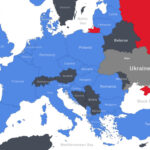Why the Misery?
Blowing Gaza’s “golden opportunity” with gassy, destructive rhetoric is what is really causing the Misery, as negotiations continue on truce talks (a six week cease-fire, according to the WSJ) with goals that seem impossible to reconcile, Paul Morland in The Spectator attempts to explain:
Inequitable Food Distribution
Among the wrong-headed arguments concerning the war in Gaza none is worse than the suggestion Gazans are/were living in such straitened circumstances that they had no choice but to “break out.”
Pro-Palestinians argue that the Gazans living in straitened circumstances are against a wall, leaving them no choice but to “break out” on 7 October.
Nonsensical Cruelty:
Even the British foreign secretary David Cameron has previously used that term, “break out,” to talk about Gaza.
In the wake of the Hamas massacre, the UN chief António Guterres insisted that the events of October 7 “did not happen in a vacuum.” Although he later denied that this was a “justification” of the murders, rapes, and kidnappings of Israelis by Gazans, Guterres’s comments tied in with a general view among Israel’s critics that conditions in Gaza were so dreadful that we can hardly be surprised at the inhabitants fighting back.
The Reality of the Warsaw Ghetto
Supporters of Palestine compare Gaza to the Warsaw Ghetto, which Mr. Morland calls an “exaggeration.”
Long before the current conflict broke out, progressives compared Gaza to the Warsaw Ghetto. The reality, of course, is that Gaza is nothing like the Warsaw Ghetto.
Jews were not breaking out of the Warsaw Ghetto to massacre local gentiles they could get their hands on.
Set aside the fact that the people of Gaza had elected — in the only free election they have enjoyed — a party sworn to eternal warfare with Israel until the state was destroyed.
Why a Port in Gaza
Put aside the fact that Gaza shares a border with Egypt, through which goods could be delivered without any requirement for supplies from Israel — as was the case during the Egyptian occupation of Gaza between 1948 and 1967.
Put aside further that the Gazans have had the resources to build an underground tunnel network that is said to be longer than the London Underground and to amass vast stocks of weapons and to fund the billionaire lifestyles of Hamas leaders.
Just how dire were the circumstances in Gaza before October 7, circumstances which, according to Israel’s detractors, provide an understandable “context” for the actions of that day? A great deal can be understood by examining demography, so often the over-looked and underestimated explanation.
An Eloquent Story
Mr. Moreland explains that the sheer growth of Gaza explains a lot of what happened in 1967 when Israel occupied the strip.
(Gaza’s) population was slightly below 400,000. By the eve of the current conflict, it had risen five-fold, an extraordinary increase in a few decades. The fertility rate in Gaza was high for most of that period: five or six children per woman until early in the current century. That is nothing unusual; it has been true of most societies historically until they reach a certain level of development.
Really fast population growth occurs in that window when a society gets improved healthcare and rising access to food and other resources — but before urbanization and education tend to lead to falling birth rates. Births remain high, deaths tumble and so the population grows rapidly. This was Britain’s experience in the nineteenth century, and it has been a trend seen throughout much of the world since.
The arrival of the Israelis in 1967 accelerated the flow of many benefits of modernity:
Infant Mortality: In the mid-1960s, example, around one baby in ten died in the Palestinian Territories before he or she reached the age of one. By the late 2010s, however, infent mortality had fallen well over 80%, a level similar to other Arab countries such as Jordan and Egypt and equivalent to the level the UK reached in the early 1970s.
Life Expectancy: Prior to the present conflict, at around 75 years, life expectancy was better than experienced by several US states and only a couple of years short of the United States as a whole. Males in Glasgow live only a few months longer than males in Gaza.
Illiteracy: A lack of education and the accompaniment cluelessness has more or less been banished. Students going to university or other tertiary education has approached 50 percent, particularly impressive when you consider that, before 1967, neither the West Bank nor Gaza had a single fully-fledged university, nor ever had had.
“Better-educated people are invariably better able to keep themselves and their offspring alive, which accounts in large part for the rising life expectancy.”
Food Distribution: Gaza’s general availability of food, despite the propagandistic claims of Hamas, was plentiful before it instigated the current war, Mr. Morland explains. Food distribution, however, was not always equitable.
There were more than four overweight children in the Occupied Territories as a whole for each underweight one. There is no doubt that there was much poverty alongside the beach resorts, five-star hotels and luxury-car dealerships which graced the Gaza Strip prior to the present conflict, but that poverty had more to do with the welfare and redistributive policies of the Hamas regime that was in place rather than any absolute restrictions on the import of goods by Israel or indeed Egypt.
Permanent peace requires a refutable of the heady, gassy and destructive rhetoric of the past.
Gaza before October 7, with its plentiful resources and long life expectancy, could not have been further from the depravity and depravation of the Warsaw Ghetto. Without Hamas’s determination to rocket Israel and row with Egypt, and without its diversion of resources in tunneling and armaments and corruption, conditions could have been much better still.
The Palestinians in Gaza and elsewhere can find their way to an infinitely better future — but only when they and their friends set aside the hyperbolic fantasies which flies in the face of incontrovertible demographic reality.






